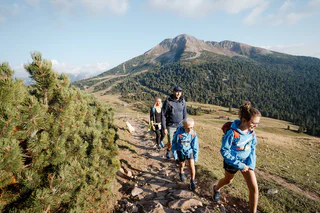
Tour of the villages Schnauders-Garn-Verdings
Caerna/Garn, Feldthurns/Velturno, Brixen/Bressanone and environs
Whether you're interested in the breathtaking Stilfser Joch National Park, the UNESCO World Heritage Dolomites, or the secluded Pfunderer Berge mountains, the region's high-altitude and long-distance hiking trails provide an opportunity for multi-day hikes that take you through stunning landscapes from one mountain hut to another. These extended hikes in the mountains offer an ideal escape from the demands of everyday life, allowing you to truly disconnect and immerse yourself in nature.

Caerna/Garn, Feldthurns/Velturno, Brixen/Bressanone and environs

1/2
Radein/Redagno, Aldein/Aldino

Laghetti/Laag, Neumarkt/Egna, Alto Adige Wine Road

1/14
Cardano/Kardaun - Bolzano/Bozen, Karneid/Cornedo all'Isarco, Dolomites Region Eggental

1/2
Nova Ponente Centro/Deutschnofen Dorf, Karneid/Cornedo all'Isarco, Dolomites Region Eggental

Anterivo/Altrei, Altrei/Anterivo

Passo Stelvio/Stilfserjoch, Stilfs/Stelvio, Vinschgau/Val Venosta

1/2
Collepietra/Steinegg, Tiers am Rosengarten/Tires al Catinaccio, Dolomites Region Seiser Alm

S. Maddalena/St. Magdalena - Casies/Gsies, Gsies/Valle di Casies

Luson/Lüsen, Lüsen/Luson

1/2
San Vigilio

1/9
Trodena/Truden, Truden/Trodena

Solda/Sulden, Stilfs/Stelvio, Vinschgau/Val Venosta

1/5
Meltina/Mölten, Mölten/Meltina, Bolzano/Bozen and environs

1/2
Plose/Plose, Brixen/Bressanone, Brixen/Bressanone and environs

Resia/Reschen, Graun im Vinschgau/Curon Venosta, Vinschgau/Val Venosta

S. Maddalena/St. Magdalena - Casies/Gsies, Gsies/Valle di Casies

1/10
Montesole/Sonnenberg - Parcines/Partschins, Partschins/Parcines, Meran/Merano and environs

Piavenna/Plawenn, Graun im Vinschgau/Curon Venosta, Vinschgau/Val Venosta

Laghetti/Laag, Neumarkt/Egna, Alto Adige Wine Road

1/3
Obereggen/Obereggen, Deutschnofen/Nova Ponente, Dolomites Region Eggental

1/5
S.Cristina Gherdëina/S.Cristina Val Gardena/S.Cristina Gherdëina/St.Christina in Gröden, S.Crestina Gherdëina/Santa Cristina Val Gardana, Dolomites Region Val Gardena

Piavenna/Plawenn, Graun im Vinschgau/Curon Venosta, Vinschgau/Val Venosta

Passo Stelvio/Stilfserjoch, Stilfs/Stelvio, Vinschgau/Val Venosta

Fontanefredde/Kaltenbrunn, Truden/Trodena

S. Maddalena/St. Magdalena - Casies/Gsies, Gsies/Valle di Casies

1/2
Vallesina/Versein, Mölten/Meltina, Bolzano/Bozen and environs

1/5
Tubre/Taufers i. M., Mals/Malles, Vinschgau/Val Venosta

Stelvio/Stilfs, Stilfs/Stelvio, Vinschgau/Val Venosta

S. Maddalena/St. Magdalena - Casies/Gsies, Gsies/Valle di Casies